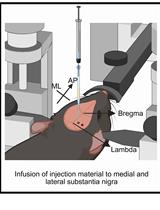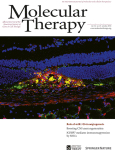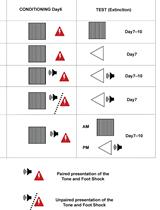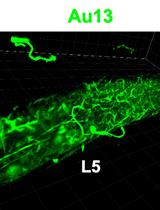- EN - English
- CN - 中文
Loading of Extracellular Vesicles with Chemically Stabilized Hydrophobic siRNAs for the Treatment of Disease in the Central Nervous System
将化学稳定的疏水siRNA加载到细胞外囊泡中用于治疗中枢神经系统疾病
发布: 2017年06月20日第7卷第12期 DOI: 10.21769/BioProtoc.2338 浏览次数: 9904
评审: Longping Victor TseVaibhav B ShahAnonymous reviewer(s)

相关实验方案

基于 rAAV-α-Syn 与 α-Syn 预成纤维共同构建的帕金森病一体化小鼠模型
Santhosh Kumar Subramanya [...] Poonam Thakur
2025年12月05日 1395 阅读
Abstract
Efficient delivery of oligonucleotide therapeutics, i.e., siRNAs, to the central nervous system represents a significant barrier to their clinical advancement for the treatment of neurological disorders. Small, endogenous extracellular vesicles were shown to be able to transport lipids, proteins and RNA between cells, including neurons. This natural trafficking ability gives extracellular vesicles the potential to be used as delivery vehicles for oligonucleotides, i.e., siRNAs. However, robust and scalable methods for loading of extracellular vesicles with oligonucleotide cargo are lacking. We describe a detailed protocol for the loading of hydrophobically modified siRNAs into extracellular vesicles upon simple co-incubation. We detail methods of the workflow from purification of extracellular vesicles to data analysis. This method may advance extracellular vesicles-based therapies for the treatment of a broad range of neurological disorders.
Keywords: RNA interference (RNA干扰)Background
siRNAs are one type of oligonucleotide therapeutics, a new class of drugs directly targeting messenger RNAs (mRNAs) to prevent the expression of proteins leading to disease phenotypes. The therapeutic application of siRNAs is extremely promising as siRNAs can be designed to target any gene, including genes not ‘druggable’ with small molecules or protein-based therapies. The progress made in the chemistry of oligonucleotide therapeutics enables the design of fully stabilized hydrophobically modified siRNAs (hsiRNAs, modified with 2’-O-Methyl or 2’-Fluoro as well as phosphorothioates and sense strand covalently conjugated to cholesterol), which promote cellular self-internalization of hsiRNAs and maintain an ability to be efficiently loaded into the RNA-induced silencing complex (RISC) (Byrne et al., 2013; Khvorova and Watts, 2017). A cholesterol conjugate, linked to the 3’ end of the passenger strand, is essential for rapid cellular membrane association (Byrne et al., 2013; Alterman et al., 2015). The single-stranded phosphorothioate tail promotes cellular internalization (Geary et al., 2015). We recently demonstrated that hsiRNAs bind cellular membranes within seconds after treatment, enter cells and promote potent gene silencing in vitro (Byrne et al., 2013; Alterman et al., 2015; Ly et al., 2017). However, upon local bolus injection in vivo in mouse brain, hsiRNA spread and efficacy are limited to the region surrounding the site of administration (Alterman et al., 2015). Whereas hsiRNAs remain therapeutically promising due to potent and specific gene silencing, their delivery to the brain hampers their advancement for the treatment of diseases in the central nervous system.
Endogenously produced extracellular vesicles mediate intercellular transfer of lipids, proteins, and RNAs between cells over short and long distances, thus playing a crucial role in health and disease (Distler et al., 2005; Muralidharan-Chari et al., 2010). The ability of extracellular vesicles to carry functional RNAs has attracted considerable interest to their use as novel vehicles to transport and deliver RNA-based therapeutics. The cargo includes siRNAs or other oligonucleotide therapeutics (Tetta et al., 2013). Strategies used to load RNA-based therapeutics into extracellular vesicles include electroporation (Alvarez-Erviti et al., 2011; Ohno et al., 2013) or overexpression of miRNAs in extracellular vesicle-producing cells (Kosaka et al., 2012; Ohno et al., 2013; Mizrak et al., 2013). Though both strategies have been able to promote the transfer of siRNA-loaded extracellular vesicles into target cells and the silencing of the target gene, they cannot be controlled or scaled up for clinical-stage manufacturing (Kooijmans et al., 2013). Moreover, electroporation compromises the integrity of extracellular vesicles (Kooijmans et al., 2013). We demonstrated the efficient loading of extracellular vesicles with hsiRNAs without modifying the vesicle size distribution, concentration and integrity. hsiRNA-loaded extracellular vesicles were shown to induce gene silencing of the target gene, huntingtin mRNA, in vitro in mouse primary neurons, and in vivo in mouse brain (Didiot et al., 2016).
Here, we describe a method exploring the ability of hsiRNAs to bind membranes to promote their loading into extracellular vesicles. The co-incubation of hsiRNAs with extracellular vesicles purified from cell culture conditioned medium, promotes loading into extracellular vesicles. We provide details on our methods for extracellular vesicles purification, loading of extracellular vesicles with hsiRNAs, size, charge and integrity characterization of hsiRNA-loaded extracellular vesicles, as well as in vivo testing of hsiRNAs-loaded extracellular vesicles in mouse brain, and data analysis. This technology may promote the loading of several other classes of oligonucleotide therapeutics (i.e., antisense, splice-switching oligonucleotides, sterically blocking oligonucleotides, aptamers and others) to extracellular vesicles, thus providing a significant leap forward to advance multiple classes of oligonucleotide therapeutics for the treatment of diseases in the brain. Subsequently, exploiting the natural properties of extracellular vesicles to functionally transport small RNAs (Valadi et al., 2007; Pegtel et al., 2010; Wang et al., 2010) offers a strategy for improving the in vivo distribution of and cellular uptake of oligonucleotide therapeutics (Zomer et al., 2010; El Andaloussi et al., 2013; Kooijmans et al., 2012; Lasser, 2012; Lee et al., 2012; Pan et al., 2012; Marcus and Leonard, 2013; Nazarenko et al., 2013; Didiot et al., 2016).
Materials and Reagents
- Tips (from 0.2 µl to 1,000 µl) (VWR)
- Paper towel
- Serological pipettes individually wrapped (from 5 ml to 50 ml) (Olympus)
- 0.22-μm filter-sterilization system (Thermo Fisher Scientific, Thermo ScientificTM, catalog number: 567-0020 )
- Tissue culture treated multilayer flask–T500 cm2 triple flask (Thermo Fisher Scientific, Thermo ScientificTM, catalog number: 132867 )
- 50 ml conical centrifuge tubes (Thermo Fisher Scientific, Thermo ScientificTM, catalog number: 339652 )
- Vacuum-connected Pasteur pipette
- 1.7 ml microcentrifuge tubes (Genesee Scientific, catalog number: 22-282 )
- Aluminum foil
- UV-transparent, flat-bottom 96-well plate (Corning, catalog number: 3635 )
- 1 ml syringe (BD, catalog number: 309659 )
- Parafilm (Bemis, Parafilm M®)
- Whatman No. 1 filter paper (GE Healthcare, Whatman, catalog number: 10010155 )
- 30 G ½ needle
- Electron microscopy grids (Electron Microscopy Sciences, catalog number: FCF2010-Ni ) and clean forceps to manipulate the grid
- Grid storage box (Electron Microscopy Sciences, catalog number: 71156 )
- Mouse (FVB/NJ) (THE JACKSON LABORATORY, catalog number: 001800 )
- 200-proof ethanol (Decon Labs, catalog number: 2805M )
- Fetal bovine serum (FBS) (Mediatech, catalog number: 35-010-CV )
- Phosphate-buffered saline (PBS) (Thermo Fisher Scientific, GibcoTM, catalog number: 14190250 )
- Protease inhibitor cocktail stock solution (Sigma-Aldrich, catalog number: P8340 )
- Cy3-labeled or biotinylated cholesterol-conjugated hsiRNAs (produced in-house)
- Cy3-OO-PNA strands, fully complementary to the hsiRNA guide strand (20 nucleotides long) (PNA Bio)
- Peptide-nucleic acid (PNA) hybridization assay (developed by Axolabs, Kulmbach, Germany)
- RIPA buffer (Thermo Fisher Scientific, Thermo ScientificTM, catalog number: 89900 )
- Proteinase K (Thermo Fisher Scientific, InvitrogenTM, catalog number: 25530049 )
- Glycine (Sigma-Aldrich, catalog number: G7126 )
- Bovine serum albumin (BSA) (Sigma-Aldrich, catalog number: A2153 )
- Saponin (Sigma-Aldrich, catalog number: S1252 )
Note: This product has been discontinued. - Glutaraldehyde (Polysciences, catalog number: 01909-10 )
- Avertin (Sigma-Aldrich, catalog number: T48402 )
- QuantiGene 2.0 Assay Kit (Thermo Fisher Scientific, InvitrogenTM, catalog number: QS0011 )
- Quantigene 2.0 Probesets (Varies by gene)
- Dulbecco’s modified Eagle medium (DMEM)
- MSC culture media (ATCC, catalog number: PCS-500-041 )
- Sucrose (Sigma-Aldrich, catalog number: S0389 )
- Tris base (TRIZMA) (Sigma-Aldrich, catalog number: T6066 )
- Hydrochloric acid (HCl) (Sigma-Aldrich, catalog number: H1758 )
- Ethylenediaminetetraacetate acid disodium salt (EDTA) (Sigma-Aldrich, catalog number: E6758 )
- Sodium hydroxide (NaOH) (~50 ml of NaOH) (Sigma-Aldrich, catalog number: 72068 )
- Potassium chloride (KCl) (Sigma-Aldrich, catalog number: P9541 )
- Sodium dodecyl sulfate (SDS) (Sigma-Aldrich, catalog number: L3771 )
- Sodium phosphate monobasic monohydrate (NaH2PO4·H2O)
- Sodium phosphate monobasic (NaH2PO4) (Sigma-Aldrich, catalog number: S3139 )
- Acetonitrile (50% acetonitrile solution, diluted in distilled H2O) (Fisher Scientific, catalog number: A998-4 )
- Sodium perchlorate monohydrate (NaClO4·xH2O) (Fisher Scientific, catalog number: S490-500 )
- Methyl cellulose (Sigma-Aldrich, catalog number: M6385 )
- PFA powder (Sigma-Aldrich, catalog number: P6148 )
- Uranyl acetate (Electron Microscopy Sciences, catalog number: 22400 )
- Oxalic acid
- Tris-HCl (pH 8.5) (Fisher Scientific, catalog number: BP153 )
- Ammonium hydroxide (NH4OH) (Fisher Scientific, catalog number: A669-212 )
- Cell culture medium (see Recipes)
- 1 M sucrose (see Recipes)
- 1 M Tris-HCl (see Recipes)
- 0.5 M EDTA (see Recipes)
- 3 M KCl (see Recipes)
- 10% SDS (see Recipes)
- 0.1 M sodium phosphate buffer (see Recipes)
- HPLC buffer A (see Recipes)
- HPLC buffer B (see Recipes)
- Glutaraldehyde, 1% (v/v) (see Recipes)
- Methyl cellulose, 2% (w/v) (see Recipes)
- Paraformaldehyde (PFA), 2% and 4% (w/v) (see Recipes)
- Uranyl acetate (4% w/v), pH 4 (see Recipes)
- Uranyl-oxalate, pH 7 (see Recipes)
- Methyl cellulose-UA, pH 4 (see Recipes)
Equipment
- Tissue culture hood
- Soft brush
- Ultracentrifuge 70 ml polycarbonate bottles (Beckman Coulter, catalog number: 355655 )
- Fixed-angle Ti45 ultracentrifuge rotor (Beckman Coulter, model: Type 45 Ti , catalog number: 339160)
- Refrigerated ultracentrifuge (Beckman Coulter, model: Optima XE )
- Refrigerated benchtop centrifuge (Beckman Coulter, model: Allegra® X-15R )
- Micropipettes from 0.5 µl to 1 ml (Labnet International, model: BioPetteTM Plus )
- Fixed-angle TLA-110 rotor (Beckman Coulter, model: TLA-110 , catalog number: 366735)
- 1.5 ml microcentrifuge adapters (Beckman Coulter, catalog number: 360951 )
- Refrigerated benchtop ultracentrifuge (Beckman Coulter, model: OptimaTM MAX-TL )
- Orbital thermo-shaker for 1.5 ml microtube (Grant Instruments, model: PHMT series )
- Plate reader spectrophotometer (Tecan Trading, model: Infinite® M1000 Pro )
- Stereotactic frame (KOPF INSTRUMENTS, model: Model 963 )
- HPLC system with fluorescent detector with autosampler (Agilent Technologies, model: HPLC 1100 series )
- Hamilton syringe (Hamilton, model: Gastight #1002 )
- Extracellular vesicles size distribution and concentration reader (Malvern Instruments, model: NanoSight NS300 )
- Extracellular vesicles charge reader (Malvern Instruments, model: Zetasizer Nano NS )
- Glass micro-electrophoresis cuvette Dip Cell kit (Malvern Instruments, catalog number: ZEN1002 )
- Transmission electron microscope (JEOL, model: JEM-1011 )
Note: This product has been discontinued. - ALZET® osmotic pumps (DURECT, ALZET, catalog numbers: 1003D and 1007D )
- Water bath at 37 °C
- Microscissors (Fine Science Tools, catalog numbers: 14060-10 ; 14002-12 )
- Set of two forceps (Fine Science Tools, catalog number: 11251-30 )
- Vibratome (Leica Biosystems, model: Leica VT1000 S)
- Autoplate washer (BioTek Instruments, model: ELx405 )
- Tissue culture incubator (Thermo Fisher Scientific, Thermo ScientificTM, model: HeracellTM 150i )
- Pipet-aid (Drummond Scientific, model: Portable Pipet-Aid® XP )
- Tissue culture phase-contrast inverted microscope (Motic, model: AE2000 )
- Anion exchange column (Thermo Fisher Scientific, Thermo ScientificTM, model: DNAPacTM PA100 )
- Heat block (Fisher Scientific, model: IsotempTM 2050FS )
- µPlate carrier (Beckman Coulter, model: SX4750 )
- -86 °C freezer (Thermo Fisher Scientific, Thermo ScientificTM, model: FormaTM 900 Series )
- Biological safety cabinet connected to vacuum (Thermo Fisher Scientific, Thermo ScientificTM, model: 1300 Series Class II , Type A2)
Software
- Nanoparticles Tracking Analysis (NTA) software
- Microsoft Office Excel (Microsoft Pack Office)
- GraphPad Prism 6 software (GraphPad Software, Inc.)
Procedure
文章信息
版权信息
© 2017 The Authors; exclusive licensee Bio-protocol LLC.
如何引用
Haraszti, R. A., Coles, A., Aronin, N., Khvorova, A. and Didiot, M. (2017). Loading of Extracellular Vesicles with Chemically Stabilized Hydrophobic siRNAs for the Treatment of Disease in the Central Nervous System. Bio-protocol 7(12): e2338. DOI: 10.21769/BioProtoc.2338.
分类
微生物学 > 微生物生物化学 > 脂质
神经科学 > 神经系统疾病 > 动物模型
生物化学 > 脂质 > 胞外脂质
您对这篇实验方法有问题吗?
在此处发布您的问题,我们将邀请本文作者来回答。同时,我们会将您的问题发布到Bio-protocol Exchange,以便寻求社区成员的帮助。
Share
Bluesky
X
Copy link











